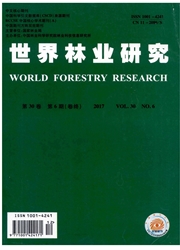

 中文摘要:
中文摘要:
选择同一杉木(Cunninghamia lanceolata)无性系幼苗为研究对象,通过设计邻株竞争处理和3个供磷水平的室内沙培模拟试验,采用破坏性收获方式,分别于试验初期、中期和末期测定不同竞争与供磷水平条件下杉木幼苗光合特性和生物量分配的变化规律,综合分析邻株竞争对低磷环境杉木响应行为的影响。结果表明:竞争处理、供磷水平和胁迫时期三者对杉木幼苗4个光合特性指标的影响均存在明显的交互作用(p〈0.05),而对生物量分配的交互作用未达显著水平(p〉0.05)。低磷和不供磷处理条件下杉木幼苗叶片的净光合速率、蒸腾速率和气孔导度均明显较低,其中缺磷胁迫和邻株竞争对叶片气孔导度的降低具有叠加效应。随着竞争和低磷处理时间的延长,杉木幼苗叶片蒸腾速率逐渐降低,但气孔导度和胞间CO2浓度呈先下降后上升的趋势,而根系生物量和根冠比均显著增加。
 英文摘要:
英文摘要:
Aims To explore the effects of neighbor competition on photosynthetic characteristics in needles and biomass accumulation and allocation of Chinese fir (Cunninghamia lanceolata) seedlings under low phosphorus (P) envi- ronment, and to investigate the complex adaptive responses of Chinese fir to available P limitation and intraspeci- fic competition. Methods The experiment was performed in a greenhouse at Fujian Agriculture and Forestry University with a Chinese fir clone named 'YANG-020'. The specially designed glass pots of 30 cm length, 30 cm width and 40 cm height were made for the P stress and competition simulation. Two seedlings were planted in each pot, except the control with a single seedling in the center of pot. All the competition treatments were involved three P supply levels: no P supply (0 mg.kg-1 KH2PO4), low P supply (6 mg.kg-1 KH2PO4) and normal P supply (12 mg.kg-1 KH2PO4). The seedlings of each treatment were harvested to determine shoot biomass, root biomass and root: shoot ratio at the prime stage (9th September, 2013), interim stage (30th October, 2013) and last stage (19th De- cember, 2013), separately, after determining the intercellular CO2 Concentration, net photosynthetic rate, transpira- tion rate and stomatal conductance in needles over the the experimental period. Important findings There were significantly three-way interactive effects among competition treatment, P sup- ply level and stress stage on the photosynthetic indexes of Chinese fir seedlings, including intercellular CO2 con- centration, net photosynthetic rate, transpiration rate and stomatal conductance (p 〈 0.05), but no significantly interactive effect was exhibited among the three factors on the biomass allocation (p 〉 0.05). Compared to the normal P supply, all of the values (i.e., net photosynthetic rate, transpiration rate and stomatal conductance) de- creased markedly in Chinese fir needles. The factors of low P supply and neighboring competition additivelyaf
 同期刊论文项目
同期刊论文项目
 同项目期刊论文
同项目期刊论文
 Litterfall production and nutrient return in different-aged Chinese fir (Cunninghamia lanceolata) pl
Litterfall production and nutrient return in different-aged Chinese fir (Cunninghamia lanceolata) pl 期刊信息
期刊信息
